Do I need a solar battery charger?
Deciding on a battery charger for your solar installation
Adding battery storage to a solar installation is a great way to be energy independent and have reliable and steady energy access. Battery storage is perfect for those living in an RV or van, and solar panels and batteries can take the place of a gas-powered generator. Battery storage can also be beneficial for homeowners who would like to go off-grid or be able to run your solar panels in the case of grid outages. What do you do when you don’t have enough steady access to sunlight to keep your batteries charged? Or let’s say you only use your solar installation intermittently throughout the year and want to keep your batteries in top condition. How do you maintain your batteries? The answer to both of these questions is to use a solar battery charger.
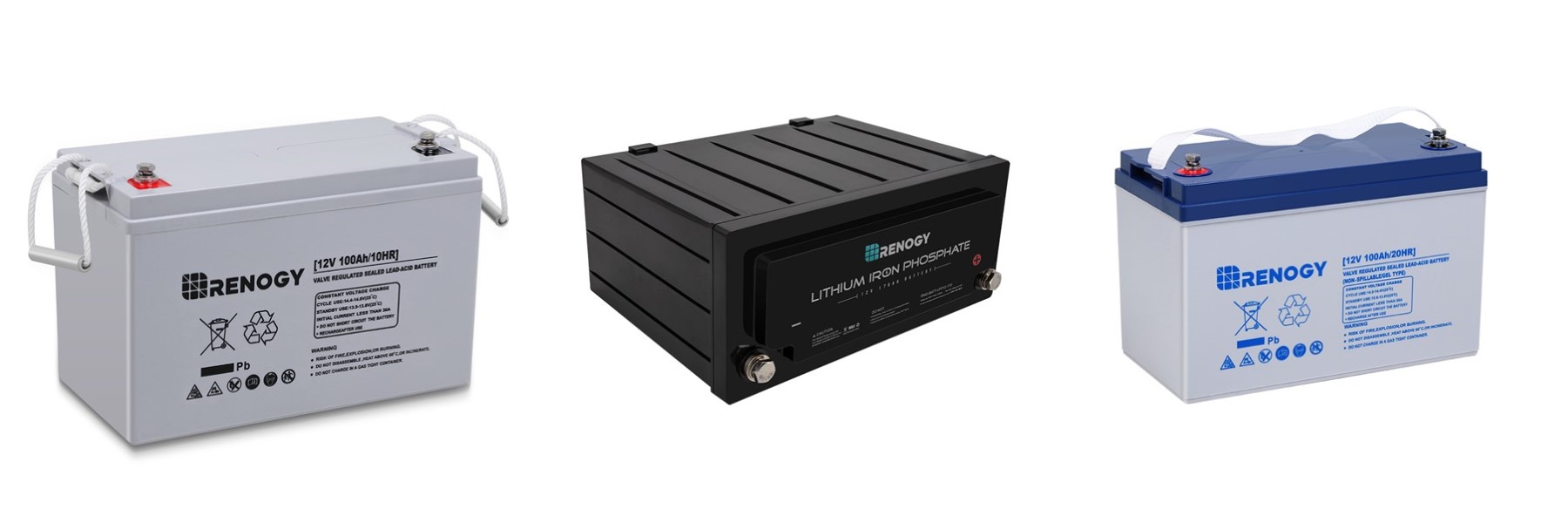
What are deep cycle batteries?
First off, let’s establish what batteries are used in solar installation, or deep cycle batteries. Deep cycle batteries look similar to car batteries, but are actually very different. In contrast to car batteries which only provide short bursts of energy, deep cycle batteries are designed to provide sustained energy over a longer period of time. Deep cycle batteries can be discharged up to 80%, but most manufacturers recommend not discharging below 45%. Regularly going beyond that point will shorten the life of the battery.
How do solar batteries work?
Solar batteries store the energy that is collected from your solar panels. The higher your battery’s capacity, the more solar energy it can store. In order to use batteries as part of your solar installation, you need solar panels, a charge controller, and an inverter.
The simple description of an installation is as follows: your solar panels will first need to be connected to a charge controller which will help monitor how much energy is stored in the batteries to prevent overcharging. Charge controllers will also shut down a system if the batteries become too depleted. Before being able to power your appliances, your batteries will need to be connected to an inverter to convert the DC energy collected from solar panels and converted to AC energy.
When using batteries for solar panels as part of a home solar system, you’re able to store the excess electricity your panels produce instead of sending that energy back into the grid. Electricity will be sent to the grid if your batteries are fully charged and your panels are still producing energy.
What are the different kinds of deep cycle batteries?
There are a few different deep cycle battery options that can be used for solar installations. The most common ones used for solar installations are flooded lead acid, sealed lead acid, and lithium iron batteries. Flooded lead acid batteries are the most inexpensive option and are available at most big-box and auto stores. Sealed lead acid batteries, available as gel and AGM batteries, store 10 to 15 percent more energy than lead acid batteries and charge up to four times faster. Lithium iron batteries are the most expensive options, but also last four times longer than lead-acid batteries and weigh much less. Most batteries in an RV battery bank are 12v batteries, so most people stick with 12v panels to be compatible.
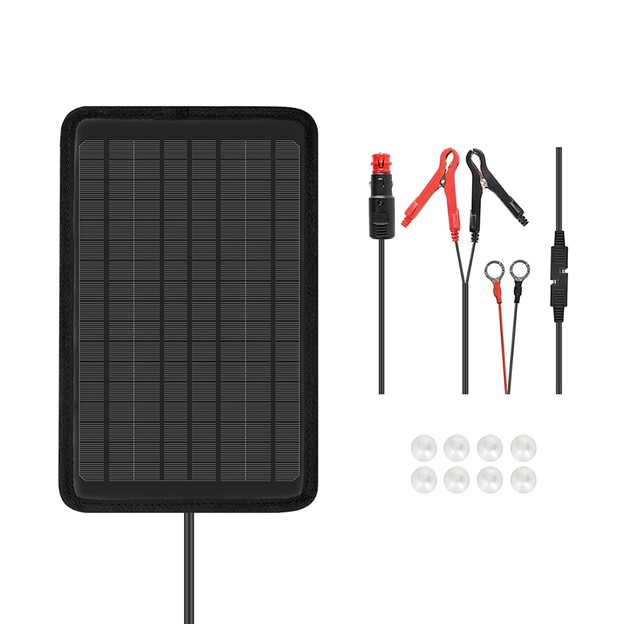
What are solar battery trickle charger maintainers used for?
When your RV remains parked in your driveway over the winter, the house batteries will gradually start to drain. It’s crucial to keep your batteries topped off and charged. If they remain unused for a long period of time, your batteries will discharge over time and they will face permanent damage. This can be avoided with a solar battery trickle charger maintainer. Trickle chargers collect enough energy to charge and safely maintain the house batteries in your RV.
Renogy has 5, 8, and 10 watt trickle chargers for flooded lead acid batteries. Using a trickle charger is quick and easy. Renogy Solar Battery Trickle Charger Maintainers include easy to use DC adaptors for direct battery connection via a cigarette lighter, alligator clips, ring terminal, or SAE connection. The high-efficiency monocrystalline solar panel can collect energy to keep your battery topped off. It’s important to know the trickle chargers are only compatible with flooded lead acid batteries and are not compatible with lithium, AGM, or gel batteries.
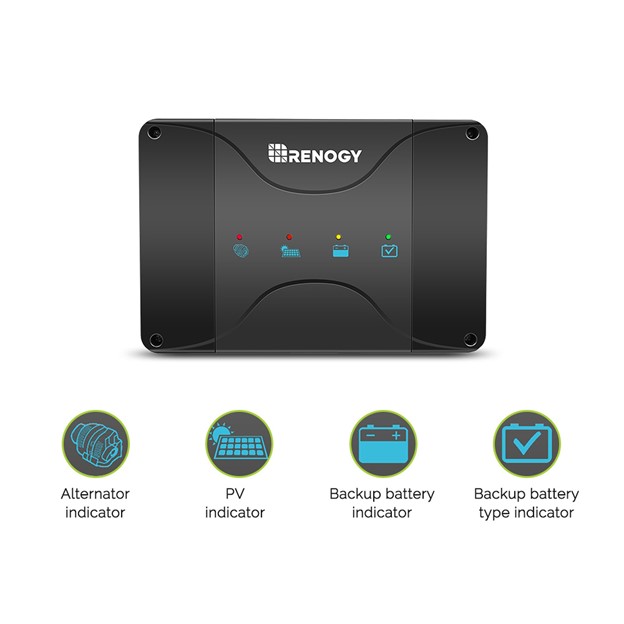
Can I charge my solar batteries with my starting battery?
Yes. Renogy's DC to DC MPPT on-board Battery Charger can charge a battery from either an alternator connected to a starting battery or by utilizing solar panels connected directly to the unit. While your vehicle's alternator prioritizes your starting battery, this unit will allow your solar system to charge your service battery first. Renogy's DC to DC MPPT Charger has you covered whether you're using Flooded, Gel, AGM, or Lithium batteries. This product is a great option for those that live in vans or RV’s.
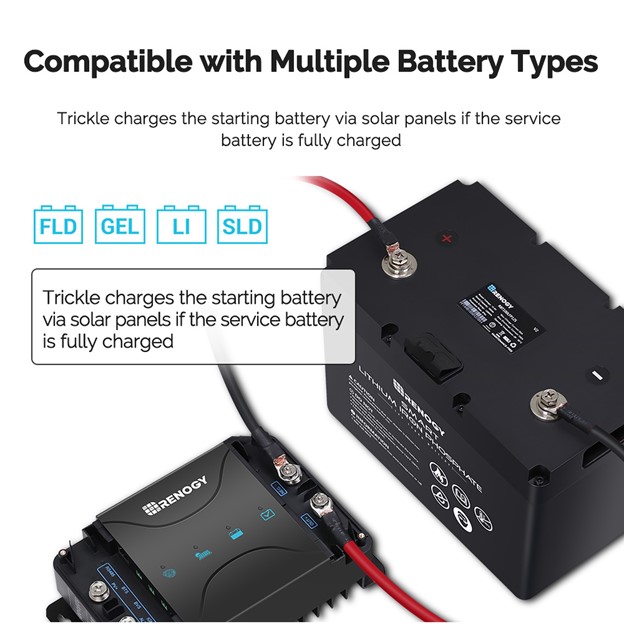
Can I charge both my house batteries and my solar battery?
Yes! You’ll need to use Renogy 30A Dual-Input DC-to-DC MPPT On-Board Battery Charger. This charger can utilize connected solar panels or an alternator linked to a starting battery. While your vehicle's alternator prioritizes your starting battery, this allows your solar system to charge your service battery first. It's the smart way to keep yourself fully charged and off-grid longer. With multi-stage charging and multi-chemistry functionality, this charger can be used with flooded lead acid, gel, AGM, or lithium batteries.
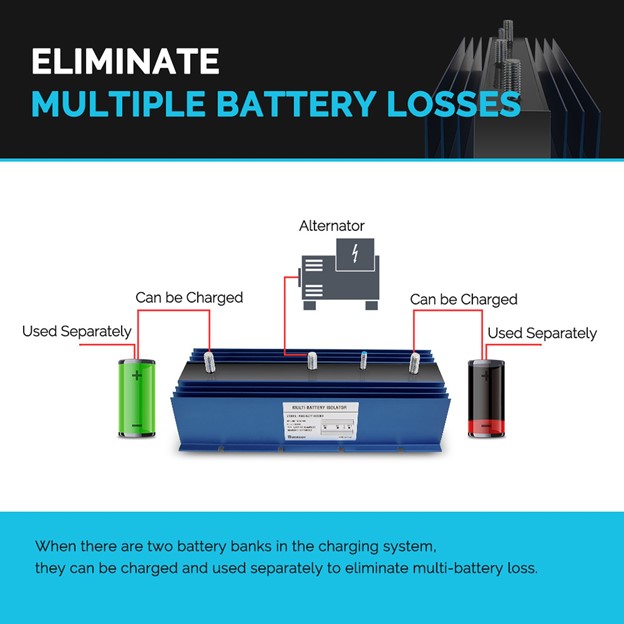
How does the 200A isolator work?
The Renogy isolator, compatible with flooded lead acid batteries, can simultaneously charge the starting and house batteries using the alternator while also keeping them isolated when discharging them. Although mainly used in RVs, the Renogy 200A Battery Isolator can be used in most motorized vehicles, allowing the alternator to charge two different battery banks at the same time. The isolator is connected to the vehicle's alternator, starting battery, and house battery. It isolates the starting battery from the house battery when using loads, and connects them when the alternator is running. The isolator is only compatible with flooded lead acid batteries.
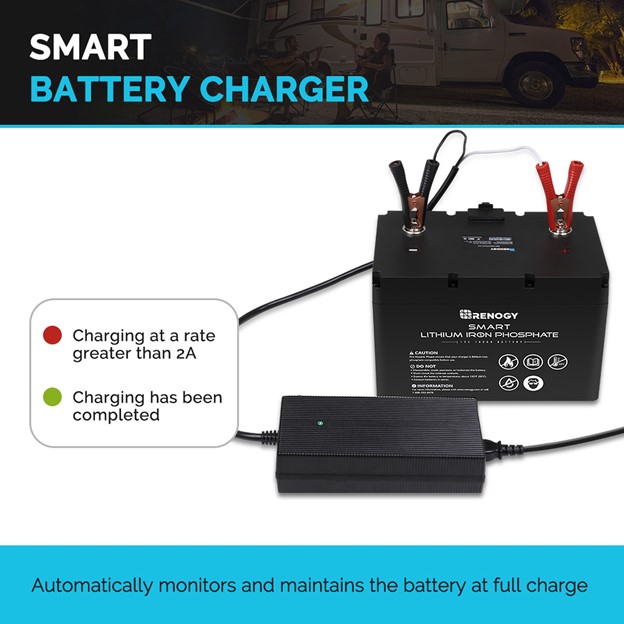
Can I charge my solar batteries with energy from an outlet?
Yes! You’ll need to use the Renogy 20A AC-TO-DC LFP Portable Battery Charger. The Renogy 20A AC to DC Charger is an automatic and portable charger designed for use with a 12V Lithium-iron phosphate batteries.This charger includes 12AWG alligator clips and outputs power based on the power, voltage, and current condition of the battery. The charger has a status indicator light for providing a visual means to determine the operating mode and condition of the battery connected to the charger. The AC-DC portable charger will automatically monitor and maintain the battery at full charge, making it a safe and efficient charging solution.
Conclusion
Battery banks are an effective way to meet all your energy needs, especially on the open road. Solar battery chargers help your battery banks stay in top condition and ensure they have long lifespans. Renogy battery chargers also give you the ability to charge your starting and house batteries, as well as connect them to AC power. Trickle chargers are great for keeping your flooded lead acid batteries topped off during dormant times. In short, solar battery chargers are versatile and powerful devices that any battery bank owner should consider adding to their solar installations.








